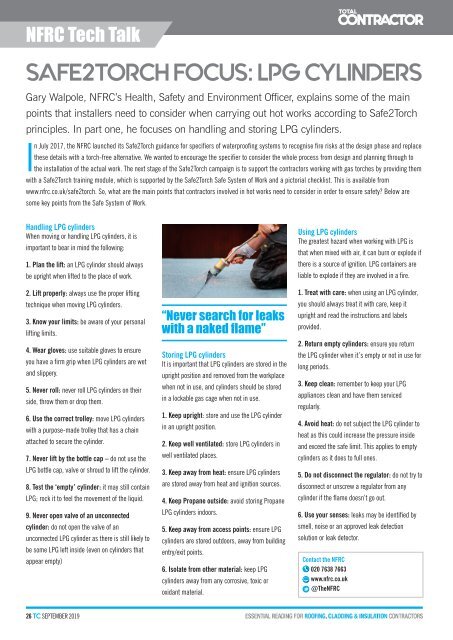September 2019
Create successful ePaper yourself
Turn your PDF publications into a flip-book with our unique Google optimized e-Paper software.
NFRC Tech Talk<br />
SAFE2TORCH FOCUS: LPG CYLINDERS<br />
Gary Walpole, NFRC’s Health, Safety and Environment Officer, explains some of the main<br />
points that installers need to consider when carrying out hot works according to Safe2Torch<br />
principles. In part one, he focuses on handling and storing LPG cylinders.<br />
In July 2017, the NFRC launched its Safe2Torch guidance for specifiers of waterproofing systems to recognise fire risks at the design phase and replace<br />
these details with a torch-free alternative. We wanted to encourage the specifier to consider the whole process from design and planning through to<br />
the installation of the actual work. The next stage of the Safe2Torch campaign is to support the contractors working with gas torches by providing them<br />
with a Safe2Torch training module, which is supported by the Safe2Torch Safe System of Work and a pictorial checklist. This is available from<br />
www.nfrc.co.uk/safe2torch. So, what are the main points that contractors involved in hot works need to consider in order to ensure safety? Below are<br />
some key points from the Safe System of Work.<br />
Handling LPG cylinders<br />
When moving or handling LPG cylinders, it is<br />
important to bear in mind the following:<br />
1. Plan the lift: an LPG cylinder should always<br />
be upright when lifted to the place of work.<br />
2. Lift properly: always use the proper lifting<br />
technique when moving LPG cylinders.<br />
3. Know your limits: be aware of your personal<br />
lifting limits.<br />
4. Wear gloves: use suitable gloves to ensure<br />
you have a firm grip when LPG cylinders are wet<br />
and slippery.<br />
5. Never roll: never roll LPG cylinders on their<br />
side, throw them or drop them.<br />
6. Use the correct trolley: move LPG cylinders<br />
with a purpose-made trolley that has a chain<br />
attached to secure the cylinder.<br />
7. Never lift by the bottle cap – do not use the<br />
LPG bottle cap, valve or shroud to lift the cylinder.<br />
8. Test the ‘empty’ cylinder: it may still contain<br />
LPG; rock it to feel the movement of the liquid.<br />
9. Never open valve of an unconnected<br />
cylinder: do not open the valve of an<br />
unconnected LPG cylinder as there is still likely to<br />
be some LPG left inside (even on cylinders that<br />
appear empty)<br />
“Never search for leaks<br />
with a naked flame”<br />
Storing LPG cylinders<br />
It is important that LPG cylinders are stored in the<br />
upright position and removed from the workplace<br />
when not in use, and cylinders should be stored<br />
in a lockable gas cage when not in use.<br />
1. Keep upright: store and use the LPG cylinder<br />
in an upright position.<br />
2. Keep well ventilated: store LPG cylinders in<br />
well ventilated places.<br />
3. Keep away from heat: ensure LPG cylinders<br />
are stored away from heat and ignition sources.<br />
4. Keep Propane outside: avoid storing Propane<br />
LPG cylinders indoors.<br />
5. Keep away from access points: ensure LPG<br />
cylinders are stored outdoors, away from building<br />
entry/exit points.<br />
6. Isolate from other material: keep LPG<br />
cylinders away from any corrosive, toxic or<br />
oxidant material.<br />
Using LPG cylinders<br />
The greatest hazard when working with LPG is<br />
that when mixed with air, it can burn or explode if<br />
there is a source of ignition. LPG containers are<br />
liable to explode if they are involved in a fire.<br />
1. Treat with care: when using an LPG cylinder,<br />
you should always treat it with care, keep it<br />
upright and read the instructions and labels<br />
provided.<br />
2. Return empty cylinders: ensure you return<br />
the LPG cylinder when it’s empty or not in use for<br />
long periods.<br />
3. Keep clean: remember to keep your LPG<br />
appliances clean and have them serviced<br />
regularly.<br />
4. Avoid heat: do not subject the LPG cylinder to<br />
heat as this could increase the pressure inside<br />
and exceed the safe limit. This applies to empty<br />
cylinders as it does to full ones.<br />
5. Do not disconnect the regulator: do not try to<br />
disconnect or unscrew a regulator from any<br />
cylinder if the flame doesn’t go out.<br />
6. Use your senses: leaks may be identified by<br />
smell, noise or an approved leak detection<br />
solution or leak detector.<br />
Contact the NFRC<br />
020 7638 7663<br />
www.nfrc.co.uk<br />
@TheNFRC<br />
26 TC SEPTEMBER <strong>2019</strong>

















